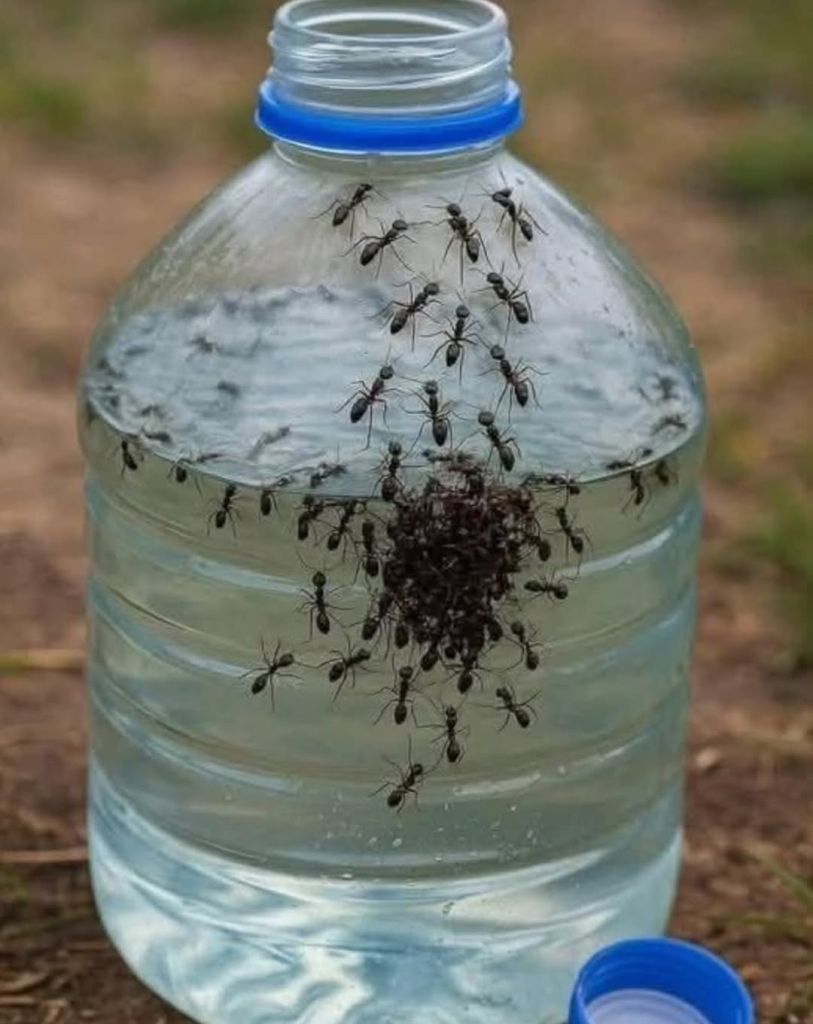At dawn, I found myself cradled in nature’s quiet embrace. The sky was pale lavender, birds still stirring, the forest breathing in rhythms too subtle to name. It was the kind of morning you wake up hoping for: calm, unhurried, full of possibility.
I wandered out to the small clearing near the tent, stepping onto damp grass. The air had that almost electric freshness — dew-touched, alive. I had filled a five-liter bottle with water the previous evening, leaving it unsealed. My intention was mundane: to have water ready for the day’s journey. But now, as I peered into it, I saw a scene that jolted me more than any sunrise ever could.
Inside the bottle, dozens — maybe hundreds — of ants flailed. Their legs kicked, tiny bodies struggled, desperate and frantic. At first glance, it looked brutal: a microscopic horror unfolding, each insect fighting to survive, everyone for itself. My gut reaction was to recoil, to step back and pretend I hadn’t seen it.
But nature has a curious way of demanding our attention.

I hesitated. Then I walked away. Yet, after some time—about two hours, though it felt both shorter and longer—I found myself drawn back to the bottle, compelled by a force I couldn’t name.
What met me then was nothing like desperation. The ants had changed. They had formed a living structure inside that liquid prison: a pyramid-shaped raft, with ants at the top supporting those below, creating space, rising and shifting in harmonious motion.
The ones at the base, those submerged, weren’t drowning eternally. They were gradually replaced by ants higher up who quietly descended to take the burden, while those below, fatigued, would rise in turn. There was no panic. No pressure. No chaos. Only a remarkable, orderly exchange of roles—each ant doing what needed doing, stepping where it was hardest, not pushing but yielding, not seeking self-preservation above all.
I felt my breath catch.
Time became irrelevant. I watched as the colony labored in silence, as though guided by an intelligence beyond instinct. Eventually, I couldn’t resist helping. I fetched a spoon and gently inserted it into the water. Without haste or alarm, ants began to climb out, crawling onto its surface, then one by one making their way to safety.
Everything was going smoothly — until one ant, weakened by exhaustion, slipped and fell back into the water. I braced myself, uncertain whether to intervene further.
Then, in a moment I will never forget, the very last ant, almost free on the spoon’s edge, turned back. It plunged into the water, clinging to its struggling comrade, refusing to leave it behind. It was as though it whispered: “Hold on, brother. I won’t abandon you.”
That act transcended instinct. I moved the spoon closer, and together, both ants emerged, alive.
What I Thought — and What It Taught Me
When I first saw them, my reaction was disgust. A mob of insects fighting to live. I judged them harshly. But as I watched, my perspective shifted. The more I observed, the more I realized: these tiny creatures had taught me more about dignity and compassion than countless sermons ever could.
I felt a swirl of shame — shame for humanity, for how often we abandon the weak, for how easily we prioritize ourselves over the community, for how many bridges we refuse to build when someone stumbles beside us.
If ants, in their microscopic world, can organize themselves, support one another, refuse to abandon the vulnerable, then what excuse do we have?
What I witnessed was not the desperate scramble of individuals, but a living, breathing testament to cooperation. It was proof that strength lies not in dominance, but in unity; that true resilience grows in the spaces between our differences, when we lift rather than push, when we stay even when leaving would be easier.
I carry that image with me now — the intertwined bodies, the calm coordination, the selfless dive — as a quiet reminder that small acts can carry immense meaning. If nature’s smallest architects can show us what it means to truly care, we ought to do more than merely take note. We should let their lesson shape how we live.